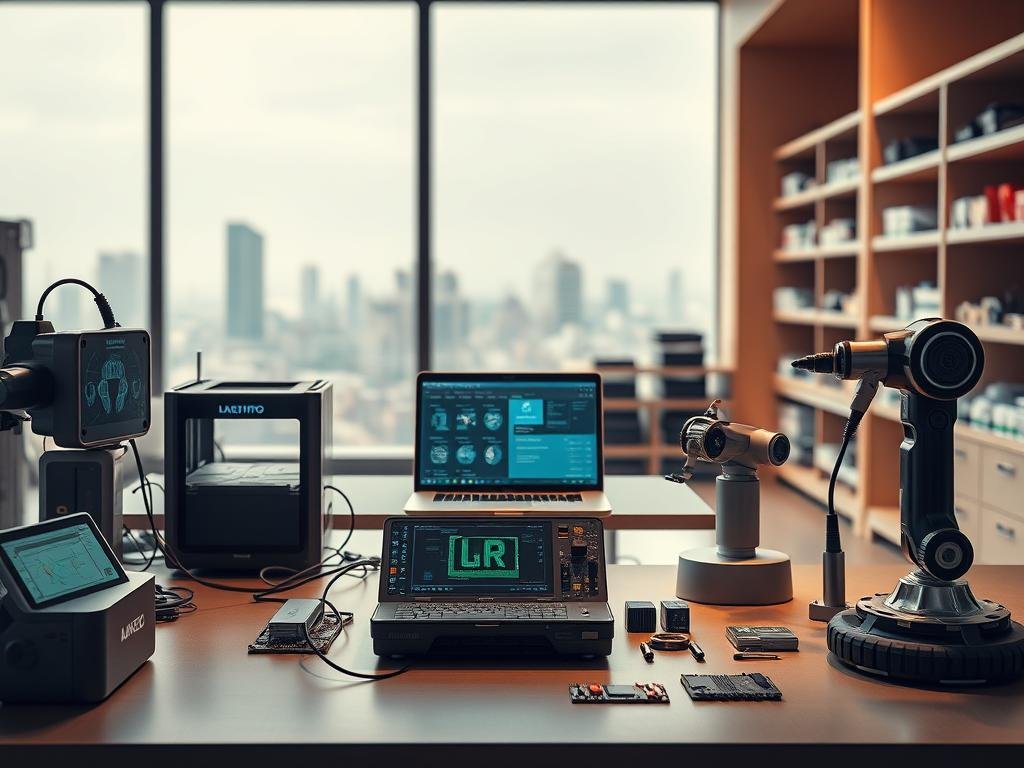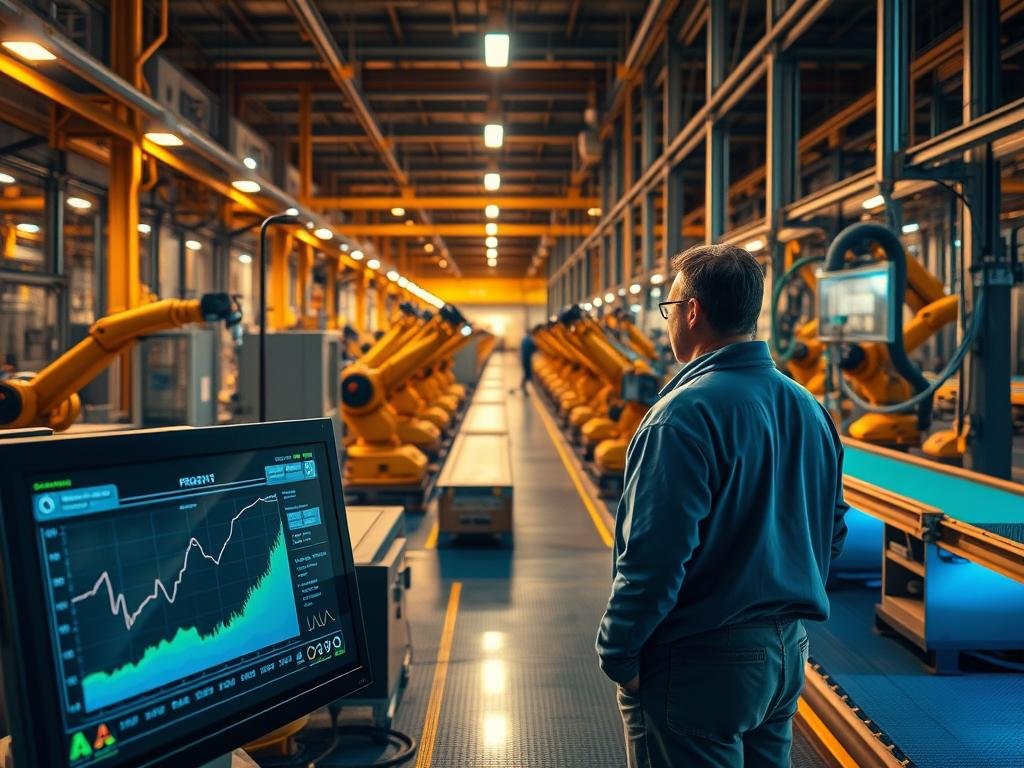Did you know that 72% of office workers experience computer problems at least once a week? This costs businesses a lot of time and productivity. Now, with AI-driven tech repair solutions, fixing computer issues is changing a lot.
Using AI tools can make fixing tech problems faster. This means less time waiting and more time working. In this article, we’ll show you how to use AI to make your tech repairs better.
Key Takeaways
- Streamline your tech repair process using AI-driven solutions
- Reduce downtime and increase productivity
- Improve diagnosis and fixing of computer problems
- Leverage AI tools to automate repetitive tasks
- Enhance collaboration through shared context models
Understanding the Role of AI in Tech Repairs
AI is changing the tech repair world a lot. As companies try to work better, knowing how AI helps is key.
What is AI, and How Does It Work?
Artificial Intelligence (AI) means making computers do things that people usually do, like finding problems or knowing when to fix things. A recent survey found 80% of manufacturing leaders want to use AI soon. AI technology for repairing devices is getting more common.
The Benefits of AI in Repair Processes
Using AI in repairs brings many good things, like working faster and less downtime. AI can look at sensor data to guess when things need fixing, so we can fix them before they break.
“AI gives industrial maintenance teams a great chance to make their work better and more efficient.”
This shows how important optimizing tech repairs with artificial intelligence is for businesses.
Common Misconceptions About AI
Even though AI is getting used more, there are wrong ideas about it. Some think AI will take jobs away from people. But AI is meant to help people, not replace them.
Another wrong idea is that AI is too hard to use. But many AI tools are easy for anyone to use.
AI Tools and Technologies for Tech Repairs
AI is changing tech repairs in big ways. It’s making repairs faster and more efficient. This is thanks to AI tools and technologies.
Overview of Leading AI Repair Tools
Many AI tools are now helping with tech repairs. Each tool has its own special features and benefits. Here are some top ones:
- AI diagnostic software can check system logs with 90% accuracy. That’s better than the 75% of old methods.
- Chatbots can solve 60% of basic computer problems. This lets human techs focus on harder issues.
These tools make repairs faster and better. They also make customers happier.

How AI Software Enhances Diagnosis
AI software is changing how we diagnose problems. It makes diagnoses more accurate and quick. A guide by Microsoft shows how AI helps field service techs.
The good things about AI in diagnosis are:
- It’s more accurate because of machine learning.
- Fixes are faster, which means less downtime.
- Customers are happier because problems get solved quickly.
Comparing AI Solutions: Pros and Cons
When looking at AI solutions for tech repairs, it’s key to know the pros and cons. Some tools are great at diagnosing but need lots of training data. Others are easy to use but don’t analyze as deeply.
Comparing AI solutions helps you choose the best one for your needs.
Streamlining Diagnostic Processes with AI
AI helps tech repair services automate fault detection. This makes diagnostics faster and more reliable. It also cuts down on human mistakes.
Automated Fault Detection: How It Works
AI uses anomaly detection to spot odd meter readings or records. It alerts technicians to check these before they confirm the data. This uses advanced algorithms to find issues humans might miss.
Key Features of Automated Fault Detection:
- Real-time data analysis
- Pattern recognition to identify anomalies
- Alerts for possible issues
In tech repair, AI checks logs and system data for faults. It predicts problems before they happen. This helps technicians fix issues early, cutting downtime and improving system reliability.
Reducing Human Error with AI Assistance
AI in tech repairs automates fault detection and cuts down on human mistakes. It gives technicians real-time advice and insights. This helps them navigate complex diagnostics accurately and consistently.
| Benefits | Description |
|---|---|
| Improved Accuracy | AI reduces human error in diagnostics |
| Increased Efficiency | Automated processes speed up diagnostics |
| Enhanced Reliability | AI-driven diagnostics provide consistent results |
As AI gets better, it will play a bigger role in diagnostics. Tech repair services using AI will see better accuracy, lower costs, and happier customers.
Enhancing Customer Experience Using AI
AI is changing how tech repairs work, making them better and more tailored to each customer. Tech repair companies use AI to offer AI-powered tech repair optimization. This makes the customer experience much better.

AI helps by giving personalized recommendations for repair services. It looks at what you’ve done before and what you might need next. This makes repairs faster and more fitting for you.
Personalized Recommendations for Repair Services
AI-driven suggestions make repairs more personal. For example, it might suggest fixes before you even notice a problem. A study on AI in customer experience shows this can make customers happier.
Chatbots and Virtual Assistants in Customer Support
AI also brings chatbots and virtual assistants to customer support. These tools are always ready to help, guiding you and setting up appointments. An article on prompt engineering for ChatGPT talks about how AI chatbots can make service better.
Using AI chatbots lets tech repair companies help more people. It also lets human technicians do harder tasks. This leveraging AI for tech repair efficiency saves money and makes things run smoother.
Predictive Analytics: Anticipating Repair Needs
Now, you can use AI-driven predictive analytics to stay ahead of tech issues. This method uses past data, algorithms, and machine learning to predict future events. It helps guess when maintenance is needed.

Understanding Predictive Maintenance
Predictive maintenance uses sensor technology and data analytics to forecast equipment failures. It lets maintenance teams plan repairs when it’s less busy. This way, they avoid unexpected downtime. By adding AI and machine learning algorithms, these models get better over time. This makes your tech repair processes more efficient.
Case Studies of Successful Predictive Implementations
Many companies have seen big benefits from predictive maintenance. For example, a manufacturing company might watch its machines closely. They only do maintenance when it’s really needed. This cuts down on costs and keeps production running smoothly.
- A leading tech firm cut unplanned downtime by 30% with AI-driven predictive maintenance.
- A manufacturing plant saved 25% on maintenance costs by optimizing its schedule with predictive analytics.
These examples show how predictive analytics can help in tech repairs. By using AI-driven tech repair solutions, you can work better, save money, and make customers happier.
Leveraging Machine Learning for Improved Outcomes
Machine learning can greatly improve your tech repair operations. It analyzes lots of data to find patterns and predict problems. This includes looking at past maintenance records and current data.
The Basics of Machine Learning in Tech Repairs
Machine learning is a part of artificial intelligence. It trains algorithms to learn from data and make predictions. In tech repairs, it helps by analyzing sensor data and maintenance logs to predict when repairs are needed.
Key applications of machine learning in tech repairs include:
- Predictive maintenance: Scheduling maintenance based on predicted failures.
- Fault detection: Identifying problems before they get worse.
- Optimized repair processes: Making repair workflows more efficient with data insights.
Training Models for Specific Repair Scenarios
To train machine learning models, you need to feed them the right data. This includes past repair records, equipment details, and operational data. This way, the models learn from past experiences and make accurate predictions for future repairs.
A study on predictive maintenance shows how important data-driven approaches are. You can learn more about it in a research paper on predictive maintenance research.
As machine learning gets better, its use in tech repairs is becoming more advanced. By using machine learning, you can make your repair operations more efficient. This leads to happier customers and lower costs.
Cost Efficiency: Saving Money with AI Solutions
AI-driven tech repair techniques are proving to be a cost-effective solution for many companies. By integrating AI into their repair processes, businesses can significantly reduce operational costs and enhance overall efficiency.

Reducing Repair Expenses
AI can help reduce repair costs by predicting problems before they become major issues. This proactive approach allows for timely interventions, minimizing the need for costly repairs down the line.
Automating routine tasks is another way AI contributes to cost savings. By handling mundane tasks, AI frees up human resources for more complex and high-value tasks, optimizing labor costs.
AI also enhances diagnostic accuracy, reducing the likelihood of misdiagnosis and the associated costs of unnecessary repairs. As noted by industry experts, “AI-driven diagnostics can significantly cut down on repair times and costs.”
“The use of AI in tech repairs not only reduces immediate repair costs but also contributes to long-term savings by extending the lifespan of equipment.”
Long-term Savings through AI Adoption
The long-term financial benefits of adopting AI in tech repairs are substantial. By reducing maintenance costs and increasing operational efficiency, businesses can achieve significant savings over time.
- Predictive maintenance helps prevent equipment failures, reducing downtime and repair costs.
- Improved diagnostic accuracy minimizes the need for repeated repairs, saving both time and money.
- Automation of routine tasks optimizes labor costs and enhances productivity.
By embracing AI solutions, companies can not only reduce their immediate repair expenses but also position themselves for long-term financial benefits. As the tech repair industry continues to evolve, the role of AI in reducing costs is likely to become even more pronounced.
Addressing Challenges of Implementing AI in Repairs
When you think about adding AI to your repair work, you’ll face some hurdles. Using AI for fixing tech issues can be tricky. But knowing the problems helps you solve them.
Overcoming Resistance to New Technologies
One big issue is getting people to accept new tech. Many repair folks stick to old ways and might not want to try AI. To get them on board, offer good training and show how AI makes things better.
Strategies for overcoming resistance include:
- Involving technicians in the selection and implementation process
- Providing ongoing training and support
- Highlighting success stories and case studies
Data Privacy and Security Concerns
Another big challenge is keeping customer data safe. AI needs lots of data, which can include personal info. Keeping this data secure is a top priority.
| Data Security Measure | Description | Benefit |
|---|---|---|
| Encryption | Protects data when it’s moving or stored | Keeps data safe from hackers |
| Access Controls | Limits who can see or change data | Less chance of data leaks |
| Regular Audits | Checks how data is handled | Makes sure everything follows rules |
By tackling these issues and using strong security, you can make AI work well in your repair team. This will make things more efficient and make customers happier.
Future Trends in AI and Tech Repairs
Looking ahead, AI will change the tech repair world a lot. New tech like generative AI and advanced machine learning will be key. They will shape the future of repairs.
New Technologies on the Horizon
Generative AI will make AI-powered repairs better. It will help find problems and fix them in new ways. This means repairs will be faster and more tailored to each device.
Evolving Tech Repair Services
AI will keep making repairs better and more focused on customers. Using AI to improve repair efficiency will be vital. This change will make services more efficient and customer-friendly.
By keeping up with these new techs, you can stay ahead. This will help you succeed in a market that’s always changing.
FAQ
What is AI-driven tech repair, and how does it work?
AI-driven tech repair uses artificial intelligence to fix technical problems. It analyzes data, finds patterns, and predicts the best repair steps.
How does AI enhance the diagnosis process in tech repairs?
AI improves diagnosis by using algorithms to analyze data and find faults. This reduces mistakes and boosts accuracy.
What are the benefits of using AI in tech repairs?
Using AI in tech repairs offers many benefits. It improves accuracy, cuts costs, and enhances customer service. It also makes repairs more efficient.
How does AI-powered customer support work in tech repairs?
AI-powered customer support uses chatbots to offer personalized help. They answer questions and guide customers through repairs.
What is predictive maintenance, and how does it anticipate repair needs?
Predictive maintenance uses AI to forecast when repairs are needed. This allows for early maintenance, reducing downtime.
How does machine learning improve outcomes in tech repairs?
Machine learning trains AI on specific repair scenarios. This enables AI to learn and make more accurate predictions over time.
What are the cost benefits of implementing AI in tech repairs?
Implementing AI in tech repairs can save money. It reduces repair costs and labor expenses, and improves resource use.
What are the challenges of implementing AI in tech repairs, and how can they be addressed?
Challenges include overcoming resistance to new tech and addressing data privacy. These can be solved through education, training, and strong data protection.
What are the emerging AI technologies that will impact tech repairs in the future?
Future tech repairs will be influenced by advanced machine learning, natural language processing, and computer vision. These will enhance diagnosis and repair.
How will AI-driven tech repair solutions evolve in the future?
AI-driven tech repair solutions will get more advanced and widespread. This will lead to better efficiency, accuracy, and customer experience.
How can businesses implement AI-driven tech repair solutions effectively?
Businesses can effectively use AI by assessing their needs and choosing the right tools. They should also train their staff.
What is the role of AI in optimizing tech repairs with artificial intelligence?
AI is key in optimizing tech repairs. It analyzes data, finds faults, and predicts issues. This enables proactive maintenance and reduces downtime.
